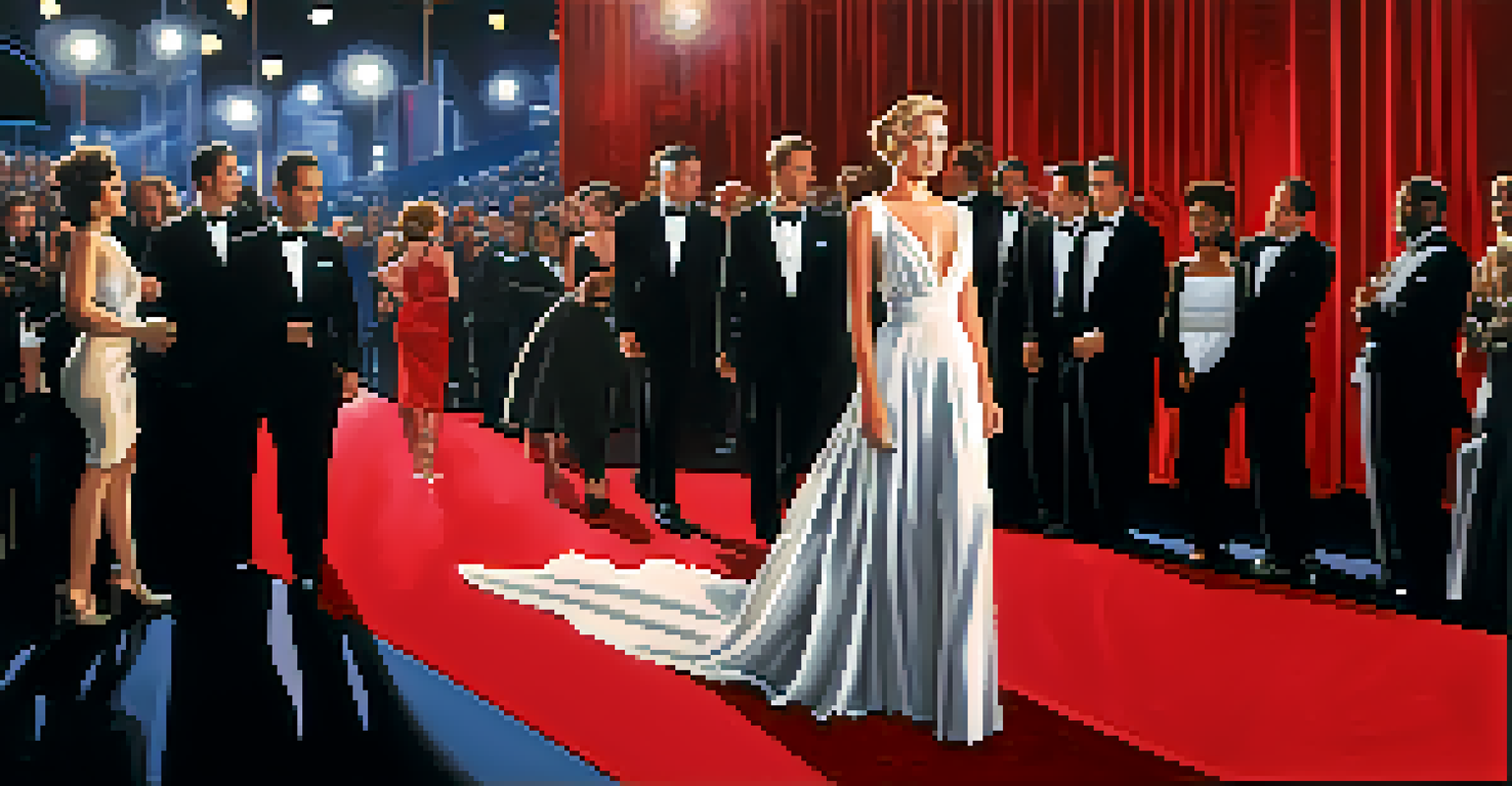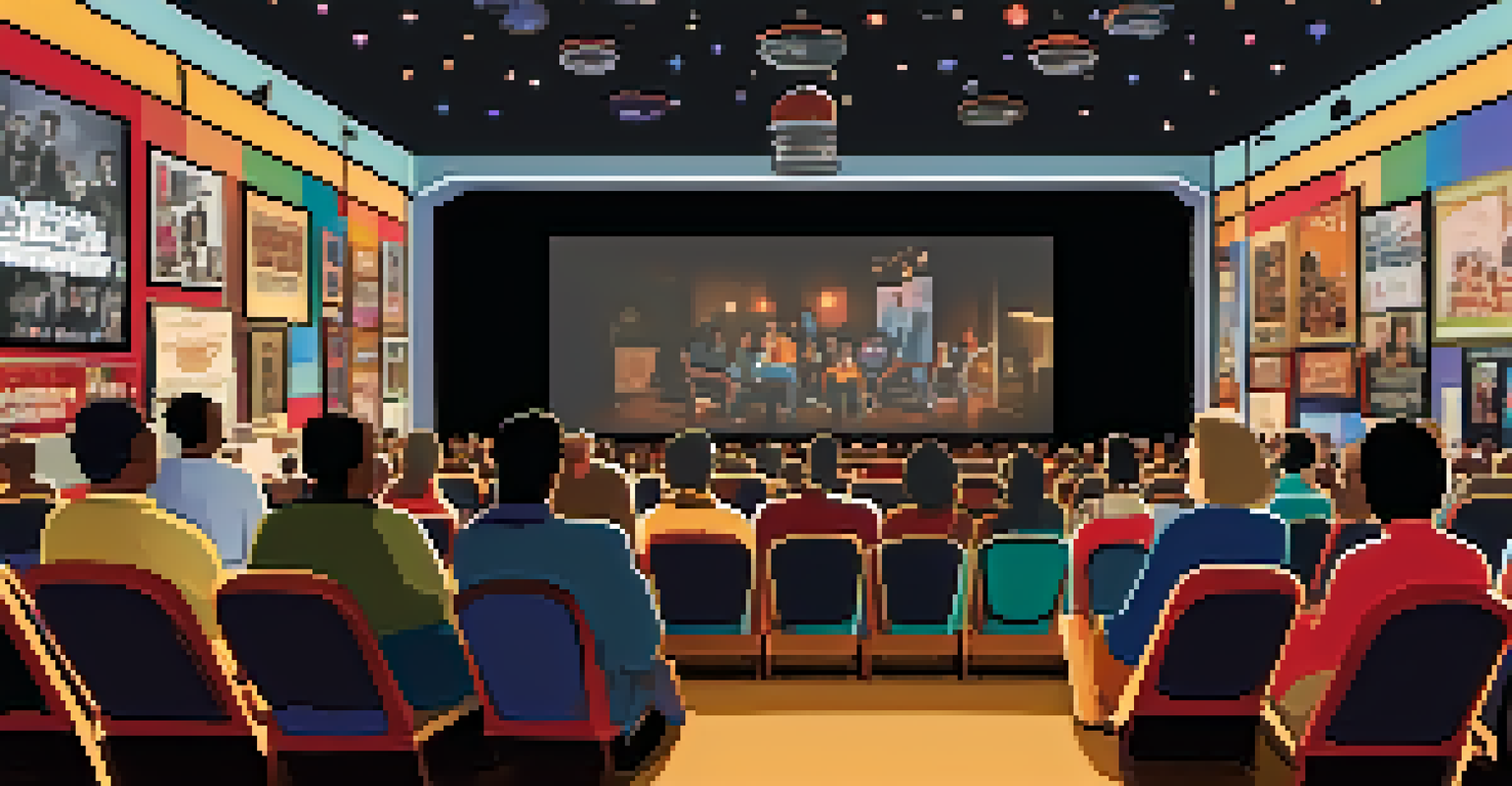The Evolution of Cultural Identity in Hollywood Storytelling

Tracing the Roots: Early Hollywood and Cultural Representation
In the early days of Hollywood, storytelling often reflected the dominant cultural narrative, primarily showcasing white, Eurocentric perspectives. Films served as a mirror to society, yet they frequently overlooked the rich tapestry of diverse cultural identities. For instance, early silent films and Westerns rarely included characters from marginalized communities, which set the stage for a narrow view of identity in cinema.
Cinema is a mirror by which we often see ourselves, and in that reflection, we must strive to present a true and authentic image of all cultures.
As the film industry grew, so did the complexities of cultural representation. The advent of sound and color brought new opportunities for storytelling, yet the portrayal of non-white characters often fell into stereotypes. This era highlighted the need for more nuanced representations, as audiences began to demand stories that reflected their own experiences and identities.
By acknowledging this historical context, we can better understand the evolution of cultural identity in Hollywood. It sets the stage for later movements that fought for broader representation, paving the way for more inclusive storytelling in the decades to come.
The Golden Age: Struggles and Stereotypes in Film
The Golden Age of Hollywood, spanning from the 1920s to the 1960s, was marked by lavish productions but also by significant cultural struggles. This period saw the rise of the Hays Code, which enforced strict moral guidelines, often limiting the portrayal of diverse cultures. Films during this time frequently relied on stereotypes, reinforcing harmful narratives about race and identity.

For example, characters of color were often relegated to side roles or depicted in ways that emphasized their 'otherness.' This not only misrepresented their cultures but also influenced public perceptions, creating a cycle of misunderstanding and bias. The impact of these portrayals was profound, as they shaped societal norms and expectations.
Cultural Representation Evolved
Hollywood's portrayal of cultural identity has transformed from narrow, stereotypical representations to more diverse and authentic narratives over the decades.
However, within this framework, some filmmakers began to challenge the status quo. By introducing more complex characters and stories that celebrated cultural richness, they laid the groundwork for future generations to push for authenticity and depth in storytelling.
The 1970s and 1980s: A Shift Towards Authentic Narratives
The 1970s ushered in a new era of cinematic storytelling that began to embrace cultural diversity more openly. This shift was partly influenced by the civil rights movement and the counterculture of the time, which demanded representation and authenticity in media. Filmmakers like Spike Lee emerged, bringing narratives that spoke directly to the experiences of Black Americans and other marginalized communities.
The power of film is that it can connect people across cultures, but we must ensure that those stories are told by the people who live them.
During this time, Hollywood started to recognize the commercial potential of diverse stories. Films like 'Shaft' and 'The Joy Luck Club' showcased characters with rich cultural backgrounds, allowing audiences to connect with their stories on a personal level. This change not only catered to a growing demand for representation but also highlighted the importance of authentic voices in storytelling.
As a result, the 1980s saw a gradual shift in how cultural identity was portrayed, moving from caricatures to more three-dimensional characters. This evolution laid the groundwork for a more inclusive Hollywood that continued to grow in the following decades.
The 1990s: Celebrating Diversity in Mainstream Film
The 1990s marked a significant turning point for Hollywood, as the industry began to celebrate cultural diversity in a more mainstream fashion. Films like 'The Lion King' and 'Selena' showcased different cultures while offering audiences relatable stories. This era saw a concerted effort to cast actors from various backgrounds, which helped to challenge the longstanding norms of representation.
Moreover, the emergence of independent cinema during this time provided a platform for underrepresented voices. Filmmakers like Mira Nair and John Singleton crafted narratives that not only entertained but also educated audiences about different cultural experiences. This movement was essential in validating the importance of diverse storytelling in Hollywood.
Challenges Persist in Authenticity
Despite progress, Hollywood still grapples with issues of cultural appropriation and the need for marginalized voices to authentically tell their own stories.
As audiences became more receptive to these narratives, the film industry recognized the value of inclusivity, paving the way for a broader understanding of cultural identity. The 1990s set a precedent for future filmmakers to explore and celebrate their unique backgrounds.
The 21st Century: A New Era of Representation
Entering the 21st century, Hollywood has witnessed a significant transformation in the landscape of cultural identity. With the rise of global interconnectedness and social media, audiences now demand authenticity and representation more than ever. Films like 'Black Panther' and 'Crazy Rich Asians' not only achieved commercial success but also celebrated cultural heritage, highlighting the richness of diverse narratives.
This era has also seen a push for more behind-the-scenes diversity, with filmmakers of color taking the helm and creating stories that resonate with their communities. This shift is crucial, as it ensures that the narratives told on screen are rooted in genuine experiences. These changes reflect a broader societal movement towards equality and understanding.
As Hollywood continues to evolve, the focus on cultural identity remains paramount. The stories being told now are more inclusive and multifaceted, allowing audiences to see themselves represented in ways that were previously unimaginable.
Challenges & Controversies: The Ongoing Struggle for Authenticity
Despite the progress made, Hollywood still faces challenges and controversies surrounding cultural representation. Issues of cultural appropriation, where elements of one culture are borrowed without proper context or respect, continue to spark debates among audiences and creators alike. For example, discussions around films like 'Avatar' and 'The Last Airbender' highlight the complexities of representation in a globalized world.
Moreover, the industry sometimes falls short in providing opportunities for marginalized voices to tell their own stories. While there have been strides in representation, the question remains: are the right people being given the platform to share their narratives? This ongoing struggle calls for a more comprehensive approach to storytelling, one that prioritizes authenticity and respect for diverse cultures.
Future Focus on Inclusivity
As streaming services rise, there is a growing demand for inclusive storytelling that reflects the rich diversity of global cultures.
Recognizing these challenges is essential for the future of Hollywood. By fostering an environment that champions genuine voices, the industry can move towards a more inclusive and representative landscape.
Looking Ahead: The Future of Cultural Identity in Hollywood
As we look to the future, the evolution of cultural identity in Hollywood storytelling appears promising yet complex. With the rise of streaming services and global audiences, there is an unprecedented opportunity to explore a myriad of cultural narratives. This new landscape allows for stories that reflect the true diversity of our world, offering rich, multifaceted portrayals of identity.
Moreover, the demand for inclusive storytelling is expected to continue growing, pushing filmmakers to innovate and break away from traditional molds. The conversation around representation is shifting, emphasizing not just visibility but also authenticity and depth in character development. Audiences today are more informed and vocal about their expectations, creating a vibrant dialogue about cultural identity.

Ultimately, the future of Hollywood storytelling hinges on its ability to adapt and embrace the diverse tapestry of human experience. By valuing authenticity and fostering a culture of inclusion, Hollywood can lead the charge in shaping a more representative narrative landscape.